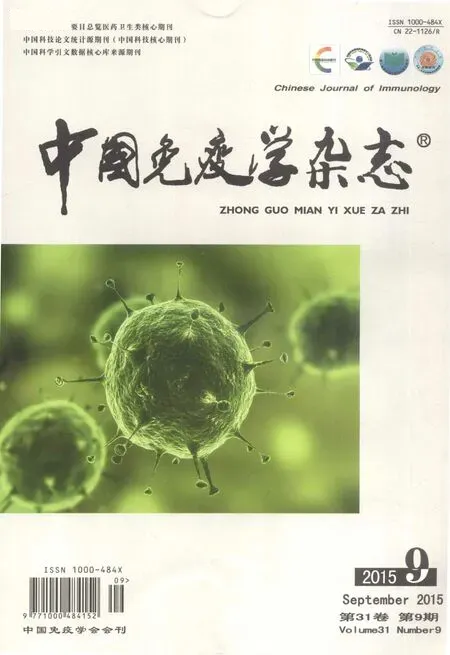高致病性流感病毒逃逸宿主固有免疫清除作用的机制
徐建青 (复旦大学生物医学研究院 上海市公共卫生临床中心,上海 201508)
人类发展的历史是与各种疾病,特别是与由病原微生物引起的传染病进行斗争的历史。从中世纪肆虐于欧洲的黑死病到上世纪初夺走5000 多万生命的欧洲西班牙大流感,及至八十年代开始的艾滋病的蔓延均注释着人类繁衍生息所面临的巨大挑战。2003 年发生的席卷全世界的“非典”与2004 年后发生的禽流感,以及2009 年在美洲爆发并流行于全球的甲型H1N1 流感病毒与近期个案报道的MERS 更为人类敲响了警钟。
自2013 年3 月以来,我国又面临着一种新型H7N9 流感的严重威胁。该新型流感有如下特点:(1)感染后存在4~18 d 潜伏期(上呼吸道),其后引起严重下呼吸道感染,约83%(76%~90%)的病人病情严重,其中老年人比例偏高,需要进ICU 和使用呼吸机[1,2];(2)重症病例抗病毒治疗(达菲)疗效差,达菲治疗2 d 即可发生耐药逃逸[3];帕拉米韦的治疗效果也有限。(3)有家庭聚簇感染发生,提示存在有限的人传人的可能[4];(4)H7N9 在禽类中致病性低,感染H7N9 的禽类很难被发现和清除;同时流感病毒片段基因具有易重组的特性,使H7N9有可能正跟当地在禽类中广泛存在的流感病毒进一步重组[5,6]。
这些特性表明:H7N9 感染人的风险将持续存在,且目前治疗手段的有效性依然有限,其致病机制依然不清。研究表明:引起呼吸道临床重症的病毒感染均出现“细胞因子风暴”现象,比如SARS、H5N1、MERS、H7N9 以及重症的2009 H1N1 等。推测:这些病原体存在共性的致病机制,能够诱导炎症因子的产生而同时逃逸宿主固有免疫应答的攻击。以H7N9 为模型,解析其逃逸宿主固有免疫应答清除作用的机制,将为了解其他高致病性呼吸道病毒的致病机制提供可能。
高致病性呼吸道病毒感染诱导的固有免疫应答:SARS 冠状病毒感染呼吸道纤毛上皮与II 型肺泡上皮细胞[7,8],重症的ARDS 患者肺中常高表达IL-1、IL-6、IL-8、CXCL-10 及TNF-α[9],但I 类干扰素与干扰素刺激基因(IFN-stimulated genes,ISGs)并未同水平上调[10],因而,SARS 也被认为是固有免疫调控失衡性疾病。在灵长类动物攻毒前给予IFN-α,可以保护动物免于SARS 的致死性攻击[11]。目前研究显示,在SARS 冠状病毒感染阶段,模式识别受体通过MyD-88 通路活化的固有免疫应答具有保护作用[12],下游干扰素受体通路JAK-STAT 通路也同样不可或缺[13,14];目前已经鉴定出10 种病毒编码蛋白具有拮抗干扰素通路的功能[15]。
2012 年新发的MERS 病毒具有极强致病性,死亡率在50%以上[16];进一步研究显示,MERS 膜蛋白能够有效感染人不同组织的细胞(包括巨噬细胞),但感染受体与已知的冠状病毒所使用的受体无关[17],病毒携带蛋白具有拮抗IRF3 介导的干扰素抗病毒作用[18],表明MERS 具备人间传播能力,且能够调控人固有免疫应答。
对于流感的研究结果与SARS 冠状病毒具有相似性。高致病性H5N1 或1918 大流感H1N1 的致病性与高炎性因子、低IFN 应答有关,其中NF-κB是高致病性病毒活化的核心信号通路[19];小鼠模型中敲除IFN 通路的IFN-γ、MxA 基因均致流感病毒的致病性升高[20,21]。有意思的是,敲除TLR4-TRIF通路能够保护小鼠免于H5N1 感染造成的肺损伤感染[22]、而在H5N1 攻击小鼠前使用LPS 预先刺激小鼠,可激活TLR4-TRIF 通路,进而在H5N1 感染时上调TLR3 的表达,并起到保护作用[23];数据表明,同样是TLR4-TRIF 通路,感染前LPS 激活具有保护作用,而感染中病毒产物激活却有损伤作用,提示通过预先调控固有免疫应答可以有效干预H5N1 的感染结局,病毒产物可异常调控固有免疫应答。灵长类动物模型研究显示:流感病毒感染可以造成感染早期持续性的Ⅰ类干扰素、炎性因子与其他固有免疫应答基因的上调,其致病力与对这些因子上调的水平成正相关,同时发现H5N1 可感染Ⅱ型肺泡上皮,而致病力弱的病毒以感染Ⅰ型上皮为主[24]。由于灵长类动物模型尚缺少动态数据,目前我们尚难以了解感染极早期的固有免疫应答情况。小鼠模型研究证明:IL7RA 敲除鼠在流感感染中存活率更好、炎性/趋化因子应答减弱,但对病毒载量影响不明显[25]。
上述研究表明,这些病原的感染可诱发固有免疫应答,呼吸道内的失衡型固有免疫应答(高炎症因子、低干扰素)与致病性有关,免疫干预调控固有免疫应答能够改变病程。
H7N9 感染诱导的固有免疫应答:研究也证明H7N9 病人发生了“细胞因子风暴”[26-29],H7N9 所引起的细胞因子水平总体上跟H5N1 相当或者稍弱,但H7N9 可以诱导比H5N1 更多的MCP-1、MIP-1β、IL-6 和IL-8[27]。我们课题组比较了死亡组和幸存组病人入院早期的细胞因子水平,发现IL-6、IL-8、MIP-1β 的水平与病人的预后相关,细胞因子水平越高,预后越差;同时感染者血及肺盥洗液中IFN 水平极低[29]。同时,我们对病人干扰素诱导穿膜蛋白3 (Interferon induced transmembrane protein 3,IFITM3)相关的单核苷酸多态性(SNP)rs12252 的分析表明,相对于rs12252 T/T 病人组,rs12252-C/C病人病毒复制水平较高,细胞因子水平较高而且预后很差,2/3 的rs12252-C/C 病人使用了呼吸机或者ECMO[29]。上述数据表明:H7N9 的致病性可能与高水平炎症因子、干扰素通路抑制病毒作用低下有关。
高致病性流感逃逸宿主固有免疫应答的机制:上述研究表明,重症流感发生的机制是由于病毒上调炎症因子分泌而抑制干扰素通路,从而突破宿主固有免疫系统的防御机制,导致肺内炎症应答不断加剧而致肺实变,出现呼吸窘迫综合征。目前已有的研究表明,重症流感可能在以下几个环节中均可逃逸固有免疫系统的抑制作用:
(1)重症流感病毒分路调控炎症因子与干扰素:流感病毒可以通过NF-kB 通路激活炎症因子的应答,但并不同时上调IFN 通路,尚不清楚流感病毒如何实现这种分别调控的。但这一调控模式可能是重症流感逃逸宿主固有免疫应答的最重要机制。
(2)突破IFITM3 的限制作用:流感病毒通过受体介导的内吞作用进入内体,内体进入胞浆之后病毒包膜与细胞膜融合释放出包含的病毒RNA(vRNA)进入胞浆,这一过程可以被IFITM3(IFN-inducible trans-membrane protein 3)分子介导的作用滞留而阻断释放[30]。但是,流感病毒均有能力突破这一限制而进入胞浆,其机制尚未阐明。
(3)抑制RIG 通路:进入胞浆的vRNA 可以被RIG-I 受体识别,从而激活RIG-I,导致RIG-I 被TRIM25 泛素化修饰,这一修饰是RIG-I 与下游的MAVS 结合所必需的过程[31]。流感病毒可以通过NS1(非结构蛋白1)抑制TRIM25,从而阻断RIG-I通路的活化。
(4)上调SOCS3 抑制干扰素通路:通过上调SOCS3 分子以抑制干扰素通路是流感逃逸宿主固有免疫应答作用的重要机制[32]。SOCS(Suppressors of cytokine signaling)家族有8 个成员,通过分子SH2结构域与靶分子结合,将靶分子导向泛素化并降解,不同的病毒上调的SOCS 成员并不相同,其中流感病毒主要上调SOCS3,我们的研究表明:SOCS 家族的其他成员也参与到流感逃逸的机制中。
(5)逃逸MxA 等ISG 基因的抑制作用:干扰素通路激活后,宿主众多的ISG 分子对病毒均有抑制作用。MxA 基因可通过使病毒RNP 多聚化成环,从而阻断病毒RNP 入核复制[33]。流感病毒可以通过突变自身NP 而逃逸MxA 的限制作用[34]。
尚未阐明的问题:回答以下四个问题将有助于进一步阐明重症流感病毒逃逸宿主固有免疫应答的机制:①重症流感病毒分路调控炎症因子与干扰素是如何实现的?②病毒是如何逃逸IFITM3 限制的?③病毒逃逸干扰素通路抑制作用是通过哪些SOCS家族成员实现的?是如何实现的?④应急应答与表观调控在流感病毒逃逸宿主固有免疫应答中的作用?
上述问题的阐明将对新药研发以及临床的免疫干预奠定理论基础。
[1]Yu HJ,Benjamin Cowling,Feng LZ,et al.Human infection with avian influenza A H7N9 virus:an assessment of clinical severity[J].Lancet,2013,382(9887):138-145.
[2]Gao HN,Lu HZ,Cao B,et al.Clinical findings in 111 cases of influenza A (H7N9)virus infection[J].NEJM,2013;368,2277-2285.
[3]Hu YW,Lu SH,Song ZG,et al.Association between adverse clinical outcome in human disease caused by novel influenza A H7N9 virus and sustained viral shedding and emergence of antiviral resistance[J].Lancet,2013,381(9885):2273-2279.
[4]Qi X,Qian YH,Bao CJ,et al.Probable person to person transmission of novel avian influenza A (H7N9)virus in Eastern China,2013:epidemiological investigation[J].BMJ,2013,347:f4752.
[5]Cui LB,Liu D,Shi WF,et al.Dynamic reassortments and genetic heterogeneity of the human-infecting influenza A (H7N9)virus[J].Nature Communications,2014,5:3142.
[6]Meng Z,Han R,Hu Y,et al.Possible pandemic threat from new reassortment of influenza A(H7N9)virus in China[J].Eur Surveill,2014,19(6):20699.
[7]Chow KC,Hsiao CH,Lin TY,et al.Detection of severe acute respiratory syndrome-associated coronavirus in pneumocytes of the lung[J].Am J Clin Pathol,2004,121(4):574-580.
[8]Sims AC,Baric RS,Yount B,et al.Severe acute respiratory syndrome coronavirus infection of human ciliated airway epithelia:role of ciliated cells in viral spread in the conducting airways of the lungs[J].J Virol,2005,79(24):15511-15524.
[9]Baas T,Taubenberger JK,Chong PY,et al.SARS-CoV virus-host interactions and comparative etiologies of acute respiratory distress syndrome as determined by transcriptional and cytokine profiling of formalin-fixed paraffin-embedded tissues[J].J Interferon Cytokine Res,2006,26(5):309-317.
[10]Cameron MJ,Ran L,Xu L,et al.Interferon-mediated immunopathological events are associated with atypical innate and adaptive immune responses in patients with severe acute respiratory syndrome[J].J Virol,2007,81(16):8692-8706.
[11]Smits SL,de Lang A,van den Brand JM,et al.Exacerbated innate host response to SARS-CoV in aged non-human primates[J].PLoS Path,2010,6(2):e1000756.
[12]Sheahan T,Morrison TE,Funkhouser W,et al.MyD88 is required for protection from lethal infection with a mouse-adapted SARSCoV[J].PLoS Path,2008,4(12):e1000240.
[13]Frieman M,Yount B,Heise M,et al.Severe acute respiratory syndrome coronavirus ORF6 antagonizes STAT1 function by sequestering nuclear import factors on the rough endoplasmic reticulum/Golgi membrane[J].J Virol,2007,81(18):9812-9824.
[14]Frieman M,Ratia K,Johnston RE,et al.Severe acute respiratory syndrome coronavirus papain-like protease ubiquitin-like domain and catalytic domain regulate antagonism of IRF3 and NF-kappaB signaling[J].J Virol,2009,83(13):6689-6705.
[15]Totura AL,Baric RS.SARS coronavirus pathogenesis:host innate immune responses and viral antagonism of interferon[J].Curr Opin Virol,2012,2(3):264-275.
[16]Perlman S,Zhao J.Human coronavirus EMC is not the same as severe acute respiratory syndrome coronavirus[J].MBio,2013,pii:e00002-13.
[17]Gierer S,Bertram S,Kaup F,et al.The spike-protein of the emerging betacoronavirus EMC uses a novel coronavirus receptor for entry,can be activated by TMPRSS2 and is targeted by neutralizing antibodies[J].J Virol,2013,87(10):5502-5511.
[18]Zielecki F,Weber M,Eickmann M,et al.Human cell tropism and innate immune system interactions of human respiratory coronavirus EMC compared to SARS-coronavirus[J].J Virol,2013,87(9):5300-5304.
[19]Viemann D,Schmolke M,Lueken A,et al.H5N1 virus activates signaling pathways in human endothelial cells resulting in a specific imbalanced inflammatory response[J].J Immunl,2011,186(1):164-173.
[20]Szretter KJ,Gangappa S,Belser JA,et al.Early control of H5N1 influenza virus replication by the type I interferon response in mice[J].J Virol,2009,83(11):5825-5834.
[21]Tumpey TM,Szretter KJ,Van Hoeven N,et al.The Mx1 gene protects mice against the pandemic 1918 and highly lethal human H5N1 influenza viruses [J].J Virol,2007,81 (19):10818-10821.
[22]Imai Y,Kuba K,Neely GG,et al.Identification of oxidative stress and Toll-like receptor 4 signaling as a key pathway of acute lung injury[J].Cell,2008,133(2):235-249.
[23]Shinya K,Ito M,Makino A,et al.The TLR4-TRIF pathway protects against H5N1 influenza virus infection[J].J Virol,2012,86(1):19-24.
[24]Baskin CR,Bielefeldt-Ohmann H,Tumpey TM,et al.Early and sustained innate immune response defines pathology and death in nonhuman primates infected by highly pathogenic influenza virus[J].Proc Natl Acad Sci USA,2009,106(9):3455-3460.
[25]Crowe CR,Chen K,Pociask DA,et al.Critical role of IL-17RA in immunopathology of influenza infection[J].J Immunol,2009,183(8):5301-5310.
[26]Chen Y,Liang W,Yang S,et al.Human infections with the emerging avian influenza A H7N9 virus from wet market poultry:clinical analysis and characterisation of viral genome[J].Lancet,2013,381,1916-1925.
[27]Zhou JF,Wang DY,Gao RB,et al.Biological features of novel avian influenza A (H7N9)virus[J].Nature,2013,499(7459):500-503.
[28]Chi Y,Zhu Y,Wen T,et al.Cytokine and chemokine levels in patients infected with the novel avian influenza A (H7N9)virus in China[J].J Infec Dis,2013,208:1962-1967.
[29]Wang ZF,Zhang AL,Wan YM,et al.Early hypercytokinemia is associated with interferon-induced transmembrane protein-3 dysfunction and predictive of fatal H7N9 infection[J].Proc Natl Acad Sci USA,2014,111:769-774.
[30]Everitt AR,Clare S,Pertel T,et al.IFITM3 restricts the morbidity and mortality associated with influenza[J].Nature,2012,484:519-523.
[31]Gack MU,Shin YC,Joo CH,et al.TRIM25 RING-finger E3 ubiquitin ligase is essential for RIG-I-mediated antiviral activity[J].Nature,2007,446:916-920.
[32]Pauli EK,Schmolke M,Wolff T,et al.Influenza A virus inhibits type I IFN signaling via NF-kappaB-dependent induction of SOCS-3 expression[J].PLoS Pathog,2008,4(11):e1000196.
[33]Matzinger SR,Carrol TD,Dutra JC,et al.Myxovirus resistance gene A (MxA)expression suppresses influenza A virus replication in alpha interferon-treated primate cells[J].J Virol,2013,87(2):1150-1158.
[34]Mänz B,Dornfeld D,Götz V,et al.Pandemic influenza A viruses escape from restriction by human MxA through adaptive mutations in the nucleoprotein[J].PLoS Pathog,2013,9(3):e1003279.

